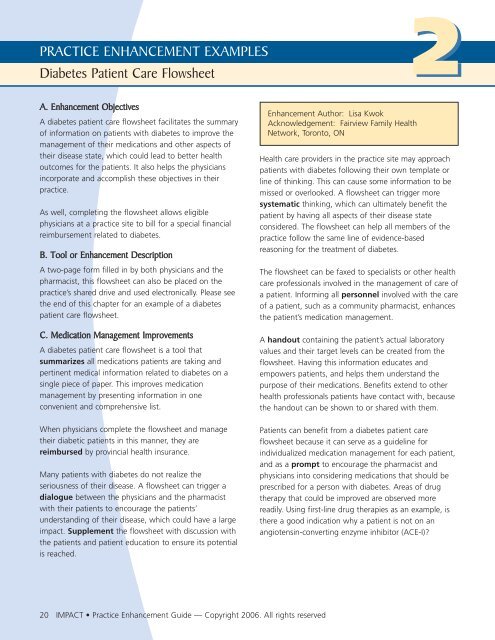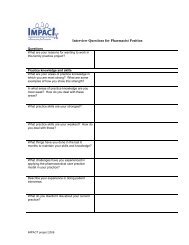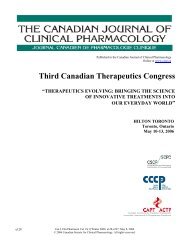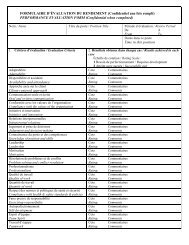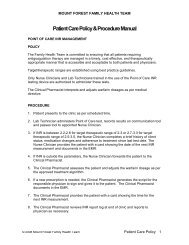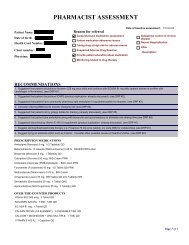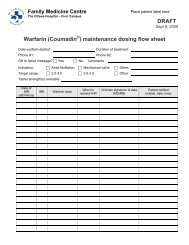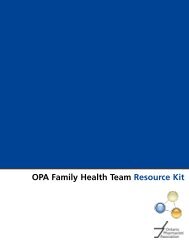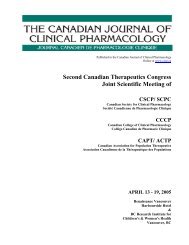Diabetes Patient Care Flowsheet - Impact
Diabetes Patient Care Flowsheet - Impact
Diabetes Patient Care Flowsheet - Impact
You also want an ePaper? Increase the reach of your titles
YUMPU automatically turns print PDFs into web optimized ePapers that Google loves.
2<br />
PRACTICE ENHANCEMENT EXAMPLES<br />
<strong>Diabetes</strong> <strong>Patient</strong> <strong>Care</strong> <strong>Flowsheet</strong><br />
A. Enhancement Objectives<br />
A diabetes patient care flowsheet facilitates the summary<br />
of information on patients with diabetes to improve the<br />
management of their medications and other aspects of<br />
their disease state, which could lead to better health<br />
outcomes for the patients. It also helps the physicians<br />
incorporate and accomplish these objectives in their<br />
practice.<br />
As well, completing the flowsheet allows eligible<br />
physicians at a practice site to bill for a special financial<br />
reimbursement related to diabetes.<br />
B. Tool or Enhancement Description<br />
A two-page form filled in by both physicians and the<br />
pharmacist, this flowsheet can also be placed on the<br />
practice’s shared drive and used electronically. Please see<br />
the end of this chapter for an example of a diabetes<br />
patient care flowsheet.<br />
C. Medication Management Improvements<br />
A diabetes patient care flowsheet is a tool that<br />
summarizes all medications patients are taking and<br />
pertinent medical information related to diabetes on a<br />
single piece of paper. This improves medication<br />
management by presenting information in one<br />
convenient and comprehensive list.<br />
When physicians complete the flowsheet and manage<br />
their diabetic patients in this manner, they are<br />
reimbursed by provincial health insurance.<br />
Many patients with diabetes do not realize the<br />
seriousness of their disease. A flowsheet can trigger a<br />
dialogue between the physicians and the pharmacist<br />
with their patients to encourage the patients’<br />
understanding of their disease, which could have a large<br />
impact. Supplement the flowsheet with discussion with<br />
the patients and patient education to ensure its potential<br />
is reached.<br />
Enhancement Author: Lisa Kwok<br />
Acknowledgement: Fairview Family Health<br />
Network, Toronto, ON<br />
Health care providers in the practice site may approach<br />
patients with diabetes following their own template or<br />
line of thinking. This can cause some information to be<br />
missed or overlooked. A flowsheet can trigger more<br />
systematic thinking, which can ultimately benefit the<br />
patient by having all aspects of their disease state<br />
considered. The flowsheet can help all members of the<br />
practice follow the same line of evidence-based<br />
reasoning for the treatment of diabetes.<br />
The flowsheet can be faxed to specialists or other health<br />
care professionals involved in the management of care of<br />
a patient. Informing all personnel involved with the care<br />
of a patient, such as a community pharmacist, enhances<br />
the patient’s medication management.<br />
A handout containing the patient’s actual laboratory<br />
values and their target levels can be created from the<br />
flowsheet. Having this information educates and<br />
empowers patients, and helps them understand the<br />
purpose of their medications. Benefits extend to other<br />
health professionals patients have contact with, because<br />
the handout can be shown to or shared with them.<br />
<strong>Patient</strong>s can benefit from a diabetes patient care<br />
flowsheet because it can serve as a guideline for<br />
individualized medication management for each patient,<br />
and as a prompt to encourage the pharmacist and<br />
physicians into considering medications that should be<br />
prescribed for a person with diabetes. Areas of drug<br />
therapy that could be improved are observed more<br />
readily. Using first-line drug therapies as an example, is<br />
there a good indication why a patient is not on an<br />
angiotensin-converting enzyme inhibitor (ACE-I)<br />
20 IMPACT • Practice Enhancement Guide — Copyright 2006. All rights reserved
2<br />
PRACTICE ENHANCEMENT EXAMPLES<br />
<strong>Diabetes</strong> <strong>Patient</strong> <strong>Care</strong> <strong>Flowsheet</strong><br />
Drug therapy can be optimized in several different<br />
ways, depending on the needs of each individual patient.<br />
Doses of existing medications can be adjusted (elevated<br />
or lowered), changes can be made in attempting to reach<br />
various targets (e.g., blood pressure or cholesterol<br />
targets), medications can be streamlined by removing<br />
a drug that is not working well or is redundant, a new<br />
drug could be added or the dosing regimen can be<br />
simplified to improve the patients’ compliance (e.g., if<br />
a patient is taking a medication three times per day and<br />
is having difficulty doing so, the regimen can be changed<br />
to once daily for that medication).<br />
“I had one patient who was put on<br />
compliance packaging. She benefited<br />
from it a lot and her diabetes<br />
medication was reduced drastically.<br />
This was very positive and rewarding<br />
to be able to make a difference.”<br />
— IMPACT demonstration project participating pharmacist<br />
<strong>Patient</strong>s may yield more benefits from a flowsheet<br />
because the monitoring of their disease state may<br />
improve. Because a flowsheet contains areas for the<br />
recording of certain laboratory values (hemoglobin A1c,<br />
lipids, etc.), the physician or pharmacist can gauge<br />
whether the patient is overdue for certain analyses.<br />
Also, the pattern of laboratory values over time can be<br />
observed. For example, if the laboratory values are not<br />
close to the target levels and remain far from target over<br />
time, this may trigger the physician to treat the patient<br />
more aggressively.<br />
Regular use of a diabetes patient care flowsheet should<br />
result in more patients with diabetes achieving their<br />
targets with their glucose levels, blood pressure,<br />
cholesterol levels, etc.<br />
Overall patient monitoring could improve by having all<br />
of the flowsheets of patients with diabetes in a central<br />
repository where the progress of each patient could be<br />
checked more easily. It may also be easier for physicians<br />
to observe trends occurring in each patient (e.g., disease<br />
improving or worsening).<br />
The organization of the practice can potentially change<br />
with the implementation of a diabetes patient care<br />
flowsheet. Some changes may be observed in the<br />
manner in which the physicians practice as a flowsheet<br />
becomes integrated into their daily routine, which can<br />
lead to changes in how the physicians manage their<br />
patients. Time may be used more efficiently because all<br />
relevant information for a patient is contained in one<br />
document.<br />
D. Development Process<br />
Physicians may be planning to create such a template<br />
and can use the presence of a pharmacist at their site<br />
as an opportunity to begin the process. In addition, a<br />
pharmacist can suggest the use of a template to the<br />
physicians of their practice site.<br />
Begin by researching different diabetes management<br />
tools available on the Internet. Ask peers and other<br />
contacts for a list of materials that can be accessed and<br />
used for initial drafts.<br />
Hold a meeting with the practice site physicians to<br />
discuss the material found and any specific needs or<br />
requests made by the physicians. The templates from<br />
the Internet may have to be modified to incorporate<br />
the needs of the physicians (e.g., more space needed<br />
for writing out medication names). Create a new form<br />
incorporating all the different areas requested by the<br />
physicians, and format it in a user-friendly way.<br />
Ensure the form created includes the criteria required for<br />
reimbursement from provincial health insurance.<br />
IMPACT • Practice Enhancement Guide — Copyright 2006. All rights reserved 21
2<br />
PRACTICE ENHANCEMENT EXAMPLES<br />
<strong>Diabetes</strong> <strong>Patient</strong> <strong>Care</strong> <strong>Flowsheet</strong><br />
After a draft is created, hold a short meeting with the<br />
physicians to obtain feedback. Needs may vary by practice<br />
site. For example, some practice sites may request that<br />
the flowsheet is organized according to disease state,<br />
while others may prefer that the patient medications and<br />
laboratory results are grouped together instead.<br />
Present each version and incorporate feedback into a new<br />
one. It can be expected that at least three drafts will be<br />
created, and require both formal and informal meetings<br />
with physicians. Depending on the practice site, the<br />
diabetes patient care flowsheet can be distributed in hard<br />
copy (if the practice site is paper-based) or electronically.<br />
Because of the possibility of the creation of a large<br />
number of drafts through the revision process, it is<br />
suggested that a working draft be implemented at the<br />
practice site to determine how the diabetes patient care<br />
flowsheet actually works in practice before making<br />
further revisions. The implementation process starts with<br />
this working draft.<br />
References and resources<br />
A diabetes patient care flowsheet incorporates<br />
information from the 2003 Canadian <strong>Diabetes</strong><br />
Association Guidelines, available at:<br />
http://www.diabetes.ca/cpg2003/downloads/<br />
cpgcomplete.pdf.<br />
The flowsheet can be an amalgamation of various flow<br />
sheets available and can be modified for the practice site<br />
physicians. For example, see:<br />
http://www.healthservices.gov.bc.ca/msp/protoguides/gps/<br />
diabetes_care.pdf (page 16).<br />
E. Implementation Process<br />
After using the flowsheet in their practice for a time, the<br />
physicians may notice that certain sections are not useful.<br />
These physicians can then provide further practical<br />
feedback for additional revisions (e.g., the lipid panel<br />
may be reorganized to reflect how the laboratory reports<br />
the values).<br />
Once a draft is finalized, store the flowsheet on the<br />
practice site’s shared drive for future use.<br />
F. Overcoming Challenges<br />
Implementing a flowsheet may present some challenges.<br />
For example, adopting it may be slower than anticipated.<br />
This can be overcome by using verbal reinforcement from<br />
the physicians at the practice site who are using the<br />
flowsheet and who find it useful. In addition, the<br />
pharmacist can fill out the flowsheet and place it in the<br />
patients’ charts to prompt the physicians.<br />
If the practice uses an electronic medical record (EMR)<br />
system, a paper diabetes patient care flowsheet may be<br />
difficult to implement, and vice versa. This challenge can<br />
be easily overcome by changing the format to one more<br />
people will use (either producing hard copies or putting<br />
the file on a shared drive for electronic use).<br />
It can be challenging when attempting to create a form<br />
that accommodates the needs of many different<br />
individuals. The revision process can be streamlined by<br />
creating a new draft only after a certain amount of<br />
feedback has been given, instead of creating a new draft<br />
for every suggestion.<br />
Challenges that may be difficult to overcome<br />
It may not be possible to include everyone’s suggestions<br />
and opinions, particularly if no consensus can be reached<br />
or if the suggestions are widely divergent.<br />
G. Facilitating Factors<br />
Involving physicians in the creative process by asking for<br />
their feedback and suggestions enhances and encourages<br />
the integration of the flowsheet at the practice.<br />
H. Evaluation Results<br />
No strategy to evaluate this enhancement was undertaken.<br />
22 IMPACT • Practice Enhancement Guide — Copyright 2006. All rights reserved
2<br />
PRACTICE ENHANCEMENT EXAMPLES<br />
<strong>Diabetes</strong> <strong>Patient</strong> <strong>Care</strong> <strong>Flowsheet</strong><br />
Practice Site Letterhead<br />
DIABETES PATIENT CARE FLOWSHEET<br />
Name:_______________________D.O.B.:____________________Chart #_______ Diagnosis Date: __________ Type of DM: _______<br />
RIsk factors: Obesity Fam Hx Smoker CVD BP Lipids Gest DM <br />
Complications/Comorbidities: Retinopathy Nephropathy Neuropathy Foot Disorders Other <br />
Past Medical/Surgical Health:____________________________________________________________________________________<br />
________________________________________________________________________________________________________________<br />
Date<br />
Diabetic medications:<br />
Oral<br />
Insulin<br />
MEDICATIONS<br />
BP medications:<br />
ACEI/ARB<br />
Diuretic<br />
Beta blocker<br />
CA++ channel blocker<br />
Lipid lowering<br />
medications:<br />
Aspirin:<br />
Other:<br />
Procedures/Targets<br />
Blood glucose:<br />
Pre-prandial 4–7<br />
Post-prandial 5–10<br />
A1C: Target
2<br />
PRACTICE ENHANCEMENT EXAMPLES<br />
<strong>Diabetes</strong> <strong>Patient</strong> <strong>Care</strong> <strong>Flowsheet</strong><br />
Fasting lipid profile:<br />
Total Chol (goal
The IMPACT Program<br />
Pharmacists in Family Practice:<br />
A Resource<br />
PRACTICE ENHANCEMENT GUIDE<br />
Optimizing Medication Use in Family Practice:<br />
Medication-focused Practice Enhancements<br />
Get the most out of your<br />
IMPACT Pharmacist<br />
The IMPACT Program<br />
Pharmacists in Family Practice:<br />
A Resource<br />
REFER IF YOUR PATIENT:<br />
• Needs help with optimal control of a chronic condition<br />
(such as diabetes, blood pressure, cholesterol, pain,<br />
arthritis)<br />
• Is taking multiple medications (to simplify, ensure<br />
appropriate dosing times, manage or prevent drug<br />
related problems)<br />
• Might be having an adverse drug event.<br />
• Has recently been hospitalized (for counselling<br />
on medication changes)<br />
• Is Most taking Common a drug at high Inhaled risk for Bronchodilators<br />
adverse events<br />
Brand Name<br />
System<br />
Salbutamol<br />
Ventolin®<br />
Generics<br />
MDI<br />
Diskus®<br />
Inhalation<br />
Terbutaline<br />
Bricanyl®<br />
Turbuhaler®<br />
Salmeterol<br />
Serevent®<br />
MDI<br />
Diskus®<br />
Formoterol<br />
Oxeze®<br />
Turbuhaler®<br />
Table 1: How Medication-focused Practice Enhancements Improve Medication Management<br />
Medication<br />
Management Process<br />
Provide group education<br />
regarding medications<br />
Completing Section 8<br />
forms<br />
Reporting adverse drug<br />
reactions (ADR)<br />
Agent Short-Acting B 2 -Agonists Long-Acting B 2 -Agonists Anticholinergics Combination<br />
Ipratropium<br />
Atrovent®<br />
MDI<br />
Inhalation<br />
Tiotropium<br />
Spiriva®<br />
HandiHaler®<br />
Problems in Family<br />
Practice<br />
<strong>Patient</strong>s need additional<br />
information on their<br />
condition; physician<br />
unable to provide all<br />
that is needed<br />
Example of Enhancement<br />
Developed<br />
Cholesterol Clinic Day (Chapter 5) —<br />
provides information that would benefit<br />
the patients and physicians of the<br />
practice site, and that is often not<br />
available in the community<br />
DIABETES PATIENT CARE FLOWSHEET<br />
Practice Site Letterhead<br />
Forms are neither readily Section 8 Forms (Chapter 6) —<br />
available nor easily Name:_______________________D.O.B.:________________Chart incorporates the forms into the #______ Diagnosis Date: _________ Type of DM: ______<br />
completed<br />
RIsk factors: electronic Obesity medical Fam Hx record Smoker(EMR) CVDto<br />
BP Lipids Gest DM <br />
Complications/Comorbidities: make use easierRetinopathy Nephropathy Neuropathy Foot Disorders Other <br />
Past Medical/Surgical Health: ______________________________________________________________________________<br />
Rarely done; voluntary ADR Forms (Chapter 6) — incorporates<br />
system; forms not __________________________________________________________________________________________________________<br />
the forms into the EMR for ADR<br />
readily<br />
Date<br />
available<br />
Diabetic medications:<br />
or easily Oral<br />
Salbutamol/<br />
Ipratropium<br />
Combivent®<br />
MDI<br />
Inhalation<br />
MEDICATIONS<br />
Insulin<br />
BP medications:<br />
ACEI/ARB<br />
Diuretic<br />
Beta blocker<br />
CA++ channel blocker<br />
Colour<br />
Onset<br />
Duration<br />
Adult Dose<br />
Blue<br />
5-15 min<br />
4-6 h<br />
1-2 pfs TID-QID<br />
PRN<br />
Blue bottom<br />
5-15 min<br />
4-8 h<br />
1-2 pfs TID-QID<br />
PRN<br />
Green/aqua<br />
20-30 min<br />
Green/aqua<br />
bottom<br />
5 min<br />
White with<br />
green cap<br />
5-30 min 30 min<br />
5-15 min<br />
12 <strong>Patient</strong> h age: _______________<br />
8-12 h<br />
4-8 or h DOB (yy.mm.dd): > 24 h _________________________<br />
4-8 h<br />
Date of last visit (yy.mm.dd): ______________________________________________<br />
MDI: 2 pfs BID 1 pf BID 2 pfs TID-QID 1 capsule 2 pfs QID<br />
Diskus®: Physician 1 pf name: BID _________________________________________________________<br />
inhaled OD<br />
Grey<br />
Clear with<br />
orange cap<br />
Chart Audit for Prevalence of Drug and Disease Indicators<br />
<strong>Patient</strong> sex: M F<br />
Chart #: ______________<br />
Site #:________________<br />
Date:_____/______/_____<br />
D M Y<br />
Excluded patients<br />
Less than one visit to the family physician in the last 12 months Yes No Don’t Know<br />
More than 20 visits to the family physician in the last 12 months Yes No Don’t Know<br />
Awaiting placement to a nursing home or long-term care Yes No Don’t Know<br />
Alcoholism Yes No Don’t Know<br />
Palliative care patient Yes No Don’t Know<br />
Family physician only sees as a home visit Yes No Don’t Know<br />
(i.e., patient cannot come to the clinic)<br />
If you chose Yes for any of the above criteria, DO NOT collect any further information on this form.<br />
The goal of the IMPACT program, as the acronym suggests, is to Integrate family Medicine and Pharmacy to Advance<br />
primary <strong>Care</strong> Therapeutics. A growing body of research supports our belief that having pharmacists working in family practice<br />
settings enhances patient care. 1 This guide is the product of more than 10 years of planning and collaboration between<br />
investigators, government and community leaders.<br />
IMPACT – Integrating family Medicine and Pharmacy to Advance primary <strong>Care</strong> Therapeutics.<br />
The IMPACT program is a demonstration project funded by the Ontario Ministry of Health and Long-Term <strong>Care</strong><br />
(MOHLTC) through the Primary Health <strong>Care</strong> Transition Fund. © 2006. The views expressed in the reports or<br />
materials are the views of the authors and do not necessarily reflect those of the Ministry.
ACKNOWLEDGEMENTS AND KEY CONTACTS<br />
IMPACT Principal Investigators:<br />
Lisa Dolovich, BScPhm PharmD MSc<br />
Kevin Pottie, MD MCISc CCFP<br />
IMPACT Co-Principal Investigators:<br />
Janusz Kaczorowski, PhD<br />
Barbara Farrell, BScPhm PharmD<br />
IMPACT Practice Enhancement Guide<br />
Editors:<br />
Lisa Dolovich, BScPhm PharmD MSc<br />
Connie Sellors, BScPhm<br />
IMPACT Practice Enhancement Guide<br />
Staff:<br />
Christine Rodriguez, IMPACT Research<br />
Assistant<br />
Christine LeBlanc, Dossier<br />
Communications<br />
Marilyn Birtwistle, CPhA Graphic<br />
Communications<br />
Collaborating Universities:<br />
McMaster University, University of Ottawa,<br />
University of Toronto<br />
Collaborating Institutions:<br />
Centre for the Evaluation of Medicines,<br />
St. Joseph’s Healthcare, Hamilton, ON<br />
Élisabeth Bruyère Research Institute,<br />
a SCO Health Service and University<br />
of Ottawa partnership, Ottawa, ON<br />
IMPACT Co-investigators:<br />
Zubin Austin, BScPhm PhD<br />
Kelly Babcock, BSP<br />
Robert Bernstein, MD PhD<br />
Ron Goeree, MA<br />
Bill Hogg, MD MCISc CCFP<br />
Gary Hollingworth, MD<br />
Michelle Howard, MSc<br />
Natalie Kennie, BScPharm PharmD<br />
Elaine Lau, PharmD<br />
Lesley Lavack, BScPhm<br />
Carmel Martin, MD PhD<br />
Connie Sellors, BScPhm<br />
John Sellors, MD MSc FCFP<br />
Gary Viner, MD<br />
Kirsten Woodend, PhD<br />
Christel Woodward, PhD<br />
Intersectorial Advisory Committee:<br />
Mary Catherine Lindberg, Chair<br />
Marsha Barnes, Ontario Ministry of Health<br />
and Long-Term <strong>Care</strong><br />
Nick Busing, University of Ottawa<br />
Wayne Hindmarsh, University of Toronto<br />
Jean Jones, Consumers’ Association of<br />
Canada*<br />
Cheryl Levitt, McMaster University<br />
Stuart MacLeod, BC Research Institute for<br />
Children’s and Women’s Health<br />
Laura Offord, Ontario Ministry of Health<br />
and Long-Term <strong>Care</strong><br />
Susan Paetkau, Ontario Ministry of Health<br />
and Long-Term <strong>Care</strong><br />
Jeff Poston, Canadian Pharmacists<br />
Association<br />
Deanna Williams, Ontario College of<br />
Pharmacists<br />
* Jean Jones passed away in March 2005<br />
after many years of contributing to the<br />
Intersectorial Advisory Committee<br />
The IMPACT team would like to acknowledge all the work<br />
and effort placed into each practice enhancement by<br />
the pharmacists and their practice sites.<br />
Beamsville Medical Centre, Beamsville, ON<br />
Pharmacist: Nita Patel<br />
Bruyère Family Health Network, Ottawa, ON<br />
Pharmacist: Natalie Jonasson<br />
Caroline Medical Group, Burlington, ON<br />
Pharmacist: Shelly House<br />
Claire Stewart Medical Centre, Mount Forest, ON<br />
Pharmacist: Robin Brown<br />
Fairview Family Health Network, Toronto, ON<br />
Pharmacist: Lisa Kwok<br />
Riverside Court Medical Clinic, Ottawa, ON<br />
Pharmacist: Rashna Batliwalla<br />
Stonechurch Family Health Centre, Hamilton, ON<br />
Pharmacist: Lisa McCarthy<br />
Stratford Family Health Network, Stratford, ON<br />
Pharmacist: Margaret Jin/Joanne Polkiewicz<br />
Contact Information:<br />
IMPACT Demonstration Project Principal Investigator:<br />
Lisa Dolovich, (905) 522-1155 ext. 3968,<br />
ldolovic@mcmaster.ca<br />
From previous page:<br />
1. Sellors J et al., A Randomized Controlled Trial of a Pharmacist Consultation Program for Family Physicians and their Elderly <strong>Patient</strong>s. CMAJ July 8,<br />
2003;169(1):17-22.<br />
2 IMPACT • Practice Enhancement Guide — Copyright 2006. All rights reserved


